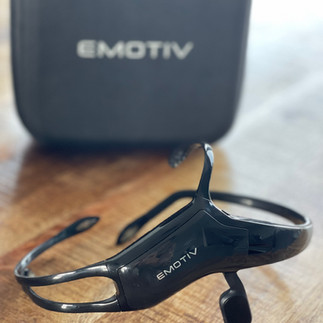Biofeedback in the Workplace: How It Can Improve Employee Health and Productivity
- Péter Dr. Zámbó
- Feb 28, 2024
- 4 min read
In today's fast-paced world, the human brain is constantly exposed to numerous stimuli, often leading to attention disorders, stress, and sleep issues. In this environment, prioritizing mental health and well-being is crucial, especially through the development of concentration and relaxation abilities. Biofeedback devices, as modern technological solutions, offer significant assistance in this area, enabling us to better understand and control our mental states.
The Netflix series "Quarterback" follows the lives of three quarterbacks, Patrick Mahomes, Kirk Cousins, and Marcus Mariota, providing insights into their experiences during games, as well as their preparation and work-life balance.
In the fourth episode, Kirk Cousins, the starting quarterback for the Minnesota Vikings, reveals his secret to peak performance. Beyond expected measures like proper nutrition, healthy sleep patterns, and rigorous training, Cousins mentions brain training through neurofeedback as part of his regimen. Quarterbacks are often placed in high-stress situations requiring quick action while maintaining focus and accuracy. This is no small challenge. Through brain training, Cousins has improved his attention and self-control over his mood, as well as reduced his reaction time. This enables him to act when necessary and as needed.
This blog explores the scientific background of biofeedback technology and its effects on concentration and relaxation. Special attention is given to the devices we use: the Muse S and the EMOTIV Insight, which have revolutionized the field of personal mental health development. We present these devices, examine their operating principles, special features, and illustrate through user experiences how they can aid in the development of concentration and relaxation skills.
Our goal is to provide a comprehensive overview of how biofeedback devices support the improvement of our mental health, with a particular focus on developing concentration and relaxation abilities. We will delve into the scientific foundations of biofeedback technology and detail the Muse S and EMOTIV Insight devices, enabling our readers to better understand the operation and benefits of these innovative solutions.
Practical Background
Biofeedback is a technique that allows for a better understanding and influence over our physiological processes. This method is built on the development of self-awareness and self-control, aiming to improve individual health and performance. But what underlies the scientific basis of biofeedback, and how can it aid in the development of concentration and relaxation?
Theoretical Foundations and Historical Overview
The roots of biofeedback trace back to the psychophysiological research of the 1960s when scientists discovered that certain autonomic nervous system functions, such as heart rate, blood pressure, and sweating, could be brought under conscious control. These early discoveries led to the development of the biofeedback technique, providing real-time feedback on our physiological state, enabling us to intentionally influence them.
How Biofeedback Works
Biofeedback fundamentally relies on measuring the body's physiological signals - such as brain waves, heart rate, skin resistance, or breathing - using sensors, and immediately communicating these data back to the user. This enables the user to learn how to affect these signals through changes in thought, emotions, and behavior, thereby improving physical and mental health.
The Efficacy of Biofeedback
Effects on Concentration
Research has shown that biofeedback techniques, especially those focusing on brain waves (EEG biofeedback or neurofeedback), can improve concentration and symptoms of attention deficit hyperactivity disorder (ADHD). Some studies suggest that neurofeedback training can help achieve brain states conducive to enhanced attention and reduced distractibility.
Effects on Relaxation
Biofeedback methods, such as respiratory and heart rate biofeedback, are particularly effective in relaxation and stress management. These techniques help learn how to reduce the physiological signs of stress, such as high blood pressure or rapid heart rate, contributing to a state of calm and relaxation.
The results of these studies highlight the importance and versatility of biofeedback techniques in developing concentration and relaxation. In our development programs, we have successfully used the Muse S and EMOTIV Insight devices for several years, exploiting these techniques to help improve their mental health and performance.
Overview of Biofeedback Devices
Biofeedback devices emerge from the intersection of modern technology and psychophysiology, aiming to make biofeedback therapy accessible and understandable to the general public. These devices allow individuals to monitor and improve their physiological state in real-time, including brain wave activity, heart rate, breathing, and more. Below, we review how these devices work and the benefits they offer users.
Types and Operating Principles of Biofeedback Devices
Brain Wave Biofeedback (Neurofeedback)
Brain wave biofeedback, or neurofeedback, focuses on measuring and providing feedback on brain electrical activity. Devices use EEG (electroencephalogram) sensors to capture brain waves, which are analyzed and feedback provided to the user in real-time, often in a gamified manner. These measured data and feedback help learn how to regulate brain states, improving concentration, reducing stress, or aiding relaxation.
Heart Rate and Breathing Biofeedback
Heart rate biofeedback devices monitor pulse and heart rate variability (HRV), while respiratory biofeedback devices observe breathing patterns and rhythm. Both types of devices assist in refining breathing techniques to reduce stress and achieve deep relaxation states.
Significance and Benefits of the Devices
Using biofeedback devices offers several advantages to users:
Increased Self-awareness: These devices enable a better understanding of physiological states and their changes under different mental conditions.
Stress Management: Biofeedback techniques allow users to learn how to manage stress and reduce its detrimental effects.
Improved Cognitive Performance: Particularly, brain wave biofeedback can be beneficial for enhancing concentration and overall cognitive performance.
Relaxation and Meditation: Biofeedback devices support achieving deep relaxation and meditative states, contributing to improved mental and physical health.
Personalized Experience: Technology enables users to receive personalized feedback, helping them more effectively achieve their goals.
The Muse S and EMOTIV Insight devices we regularly use are prime examples of how biofeedback technology can be utilized for personal development and well-being improvement.
Our next newsletter will provide a detailed introduction to these devices.
#MentalHealthAwareness #Biofeedback #Neurofeedback #StressManagement #PeakPerformance #BrainTraining










Comments